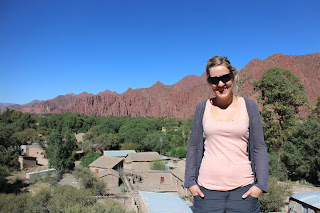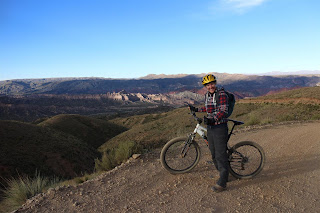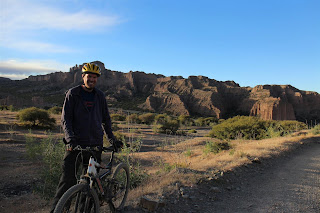See more photos from this post on Facebook.
As mentioned at the end of our last blog, we took a night bus to Tupiza. After a seven and a half hour journey along an unpaved bumpy road, we arrived in Tupiza and booked into our hotel at 4am. The town has a distinctly wild west vibe, which it gets from the surrounding canyons and rock formations. It’s other claim to fame is that Butch Cassidy and the Sundance Kid met their demise in a nearby town after a shoot-out with the Bolivian army in a saloon.
Tupiza is a really nice town, which, after the barronness and isolation of Uyuni, was a welcome relief. It also seemed to have a little more money than other small towns we’d seen, which maybe attributed to it’s proximity to Argentina. While the tourism industry is still relatively underdeveloped, there are still some great activities to do, such as the triathlon of a four-wheel-drive, horse-riding and mountain biking – which we did on our second day.
4wd trip
The surrounding volcanic countryside was truly amazing where different coloured rock layers stratified the mountains and carved through the valleys. The wind and the rain also altered the landscape whipping through the canyons and cutting through and around the rock, leaving large towering columns behind. We had lunch by the Rio Tupiza, which plays an important role in irrigating the otherwise arrid land. While the landscape was very impressive, we were anxious to get out of the jeep after the three days driving on the salt flat.
Horse riding
 After lunch, we headed to a local farm where we were sorted out with horses. The horses were not the tired out, old, lazy horses unexperienced riders are usually given, but were young, lively and full of energy. One of the horses has a fairly young foal, which came with us on the ride, running beside its mother and generally running ahead and increasing the speed of the entire group whenever it got bored. Heading into the canyons on horseback was very relaxing and a bit more authentic than whizzing through them in the jeep.
After lunch, we headed to a local farm where we were sorted out with horses. The horses were not the tired out, old, lazy horses unexperienced riders are usually given, but were young, lively and full of energy. One of the horses has a fairly young foal, which came with us on the ride, running beside its mother and generally running ahead and increasing the speed of the entire group whenever it got bored. Heading into the canyons on horseback was very relaxing and a bit more authentic than whizzing through them in the jeep.
 We passed a farmer hearding goats through the area. The goats jumped and scampered the walls of the canyons, searching for food. Much of the land seems to be communally owned, where animals are constantly hearded through. Matt, unluckily because of his height, was given the biggest horse, which asserted himself as the leader and had no problem pushing his way to the front of the pack – biting the other horses on the way and generally causing trouble.
We passed a farmer hearding goats through the area. The goats jumped and scampered the walls of the canyons, searching for food. Much of the land seems to be communally owned, where animals are constantly hearded through. Matt, unluckily because of his height, was given the biggest horse, which asserted himself as the leader and had no problem pushing his way to the front of the pack – biting the other horses on the way and generally causing trouble.
It was also Matt’s horse which stumbled and fell onto his knees, startling the horse immediately behind, who took off on a sideways gallop and threw off his rider – an unfortunate Canadian, who’d never been on a horse before. The guy, thankfully, was okay and escaped with only losing a fingernail. We were all a little spooked by the incident and were happy to head back to the farm and swap our horses for mountain bikes.
Mountain biking
Tupiza sits at 3160m above sea level, and we climbed another 1500m before beginning our descent. In South America, we have learned that the price can nearly always be dropped as agencies compete for the tourist dollar. While we have generally shopped around and gone for the medium-to-higher end of the spectrum, in this case we didn’t and just presumed the bikes and equipment would be okay. They weren’t.
The guides were very blaise about helmets and didn’t even have one big enough to fit Matt´s head. In the end, he just strapped it on as best he could and took it relatively easy. The bikes themselves were cheap and old with bad suspension and sticky brakes. Winding our way down the mountain, with a 1.5km drop in altitude, meant leaning on the brakes pretty hard, which hurt your fingers, while the lack of suspension battered your wrists and knees. It was a good lesson before taking on the Death Road just outside La Paz, where the difference in price and quality of equipment also differs greatly.
.jpg)
.jpg)




.jpg)